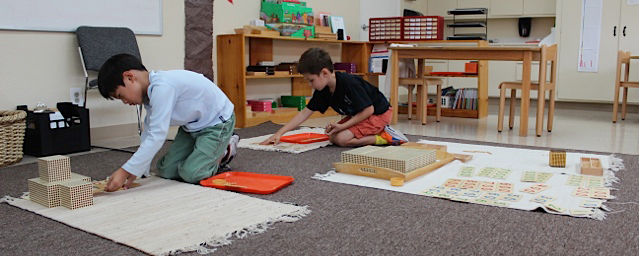Movement, Montessori and Active Children
Why is it that boys struggle more in elementary school than girls do?
Study after study show that girls outperform boys in elementary school. Boys are more likely to be diagnosed with learning disabilities, especially in elementary school. 60-80% of learning disabilities occur in boys, and boys are two to four times as likely to be labeled as ADHD than girls. At all ages, the National Assessment of Educational progress shows that girls outperform boys at reading and writing tasks.
At LePort, our holy grail is individualization. Our approach is to observe, identify, and address the needs of the particular students under our care. As a result, we’re generally not interested in whether the "average" boy struggles with reading or the "average" girl is less confident in math. We believe that in the big picture, over time, boys and girls both need to acquire the same fundamental content and learn the same key skills, and that they are both capable of doing so.
That said, we’re open to research suggesting that boys and girls may, at certain periods of their development, have different needs. There’s no denying that in schools across the country, boys on average perform far more poorly in elementary school. In their book Raising Cain: Protecting the Emotional Life of Boys, Dan Kindlon and Michael Thompson, two of the country’s leading child psychologists, argue that this is a reflection of two well-established developmental differences between boys and girls:
The first … is that girls’ verbal abilities, on average, mature faster than boys’: they talk earlier and more fluently. Boys tend to catch up later, but in the early grades especially, feminine superiority in this area is readily apparent to parents, teachers, and researchers. The second difference is that boys tend to be more physically active than girls, moving faster and staying in motion longer. [Emphasis added.]
According to the authors, many boys struggle in early elementary school because it is not optimized for their learning needs. Alan, a 12-year-old in therapy with one of the authors, offered a simple insight into the cause for this struggle.
He talks some more about classes he likes—not many—and those he doesn’t like, and it’s clear that, whatever sophisticated planning has gone into curriculum design at Alan’s school, the distinction between a good class and a bad class, from his point of view, has a lot to do with the freedom it offers to stand up and walk around.
In his weary review of life at school, Alan has described the nature of the problem so many boys have there. In essence, they sit all morning … And if they can’t move around, they feel trapped and turned off to anything the teacher might have to offer.
On top of being trapped, many boys experience themselves as "slow" in elementary school. They often enter with pre-reading skills behind those of same-aged girls, and may not be developmentally ready for the one-size-fits-all instruction in reading and writing found in traditional classrooms.
If it is true that on average, boys develop verbal abilities later than girls, and that on average, they need to move around more often than girls, then it is no surprise that on average, more boys struggle upon entering a traditional first grade classroom. In such a classroom, students are expected to sit still; they are expected to work precociously without regular opportunities to move around and recharge; they are not given space to learn, over time, to channel their energy, to redirect it from physical to intellectual activity.
Fortunately, whether or not it’s true for traditional schools, this is not the experience a boy (or girl) would have at LePort. Far from limiting ourselves to merely differentiating between boys and girls, our lower elementary class differentiates between the needs of each and every child, boy or girl.
Montessori elementary provides an environment where each child can develop at his or her own pace, and thereby avoids presenting more active boys with the challenges they typically face.
- The Montessori environment allows for freedom of movement. Montessori elementary classrooms retain the same set-up a Montessori child is familiar with from his preschool years. Students choose their activities. They pick a place to work—a mat on the floor, a table. They can get up and move around the classroom when they want to, whether it is to go get a pencil, use the bathroom, have a snack, or to observe a peer at work. All this movement happens in the same deliberate, courteous way the children have learned in their preschool classes, as students carefully walk around mats, tables and shelves, and talk with each other in quiet indoor voices.
- Instruction is individualized, and allows each child, boy or girl, to grow at a natural pace, optimized by the teacher in response to particular, individual observations of that child’s strengths and weaknesses. If it happens to be that girls come into the elementary class with nicer cursive handwriting and more fluid reading, no problem. Boys who need more time to develop these skills find that time in Montessori. And teachers know to tie in boy interests to verbal skills. A boy who is captivated by geography may find himself reading about the animals and plants of different continents, and creating detailed maps showing a continent’s physical features. In the process, he improves his reading, fine motor and writing skills.
- Montessori primary helps students develop critical early skills they otherwise might lack. If it is the case that boys on average take a little longer to "put together" all the foundational skills they’ve acquired, the 3rd year in primary Montessori is well suited to address that circumstance. This last year in primary helps students refine their fine motor skills. It offers a chance to learn language skills in an active way not found in traditional schools: an insightful teacher may help a very active student become engaged in reading by asking him to fetch items from all over the room after reading little labels. She might place him in the far corner of the room, with a moveable alphabet box, and ask him to walk across the room to her for each word he should write.
The authors of Raising Cain provide a critical piece of advice to parents of boys entering elementary school, advice which is just as applicable for parents of girls:
The most important thing to remember, the guiding principle, is to try to keep your son’s self-esteem intact while he is in school. That’s the real risk to this success and to his mental health. Once he’s out of school, the world will be different. … But if he starts to hate himself because he isn’t good at schoolwork, he’ll fall into a hole that he’ll be digging himself out of for the rest of his life. [Emphasis added.]
If you are a parent of an active child, boy or girl, and are at all concerned with how your child will adjust to a sit-still, work-book focused traditional first grade classroom, consider keeping him (or her) in Montessori at least for the early elementary grades. With the careful guidance of our expert teachers, by 3rd grade he’ll master the skills so many active children struggle with in traditional school.
Most importantly, he’ll retain the love of learning he’s gained in preschool, and continue to view himself as a capable, likeable young person.
Isn’t that the best gift your could give your child at the start of his school years?









